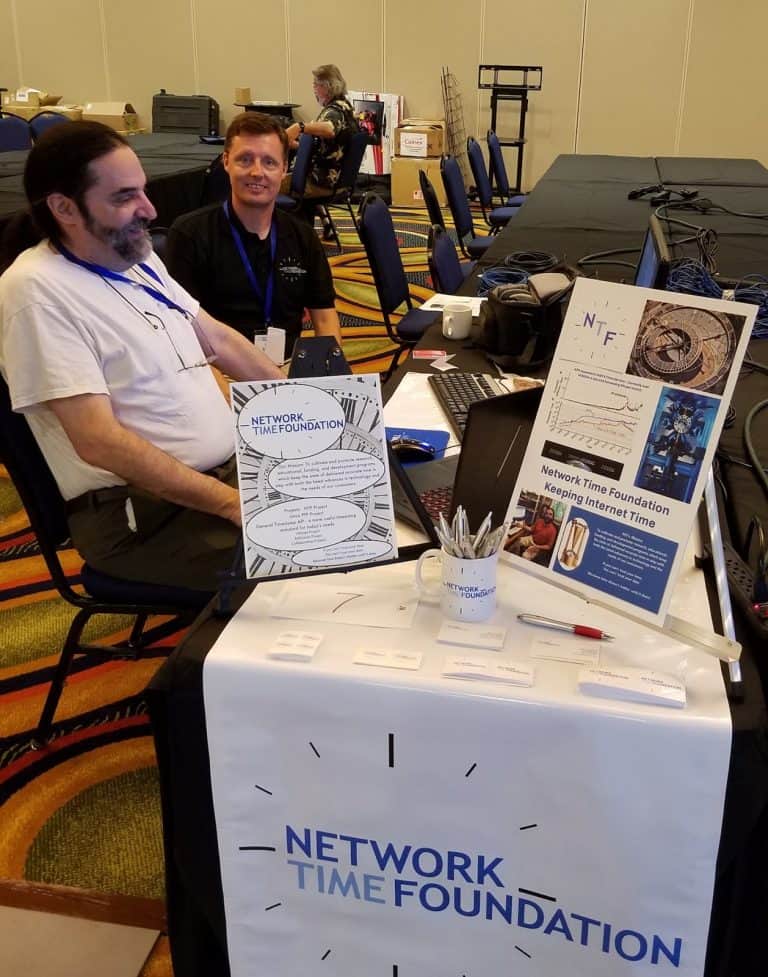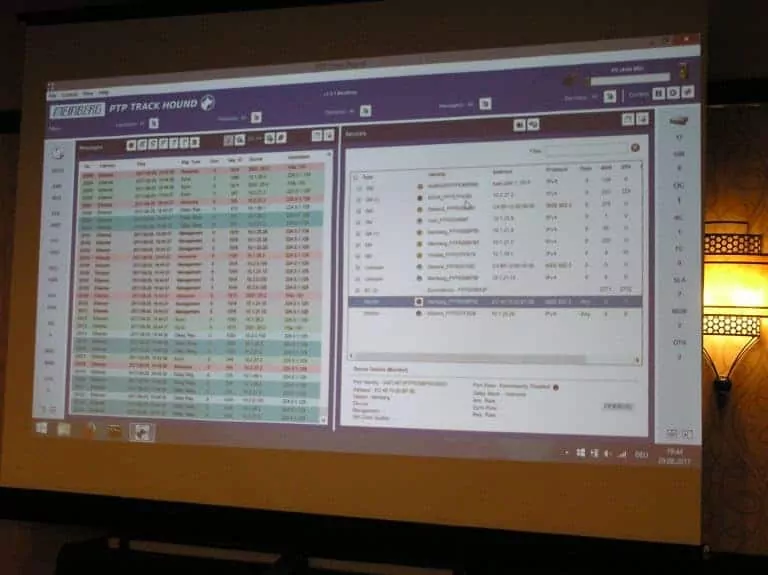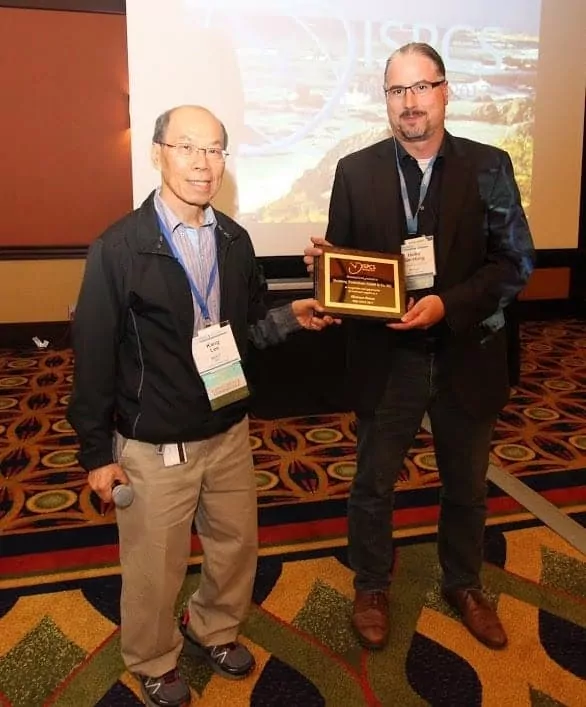Last week, I joined Harlan Stenn at the 2017 ISPCS Conference (International IEEE Symposium on Precision Clock Synchronization for Measurement, Control, and Communication) where we attended the Plugfest and heard the latest developments in the PTP community. This was NTF's fifth time at the event and the organization would like to extend its sincere appreciation to Meinberg, an NTF Premier-Level Institutional Member since May of 2013, for making our attendance possible by sponsoring our registration and accommodation costs. And special thanks to Heiko Gerstung, Managing Director, for his approval.
ISPCS Plugfest
During the Plugfest, which took place over the first three days of ISPCS, we tested a variety of PTP profiles using LinuxPTP, including the latest two telecom profiles, which will soon be available for LinuxPTP. Test scenarios included rogue masters, leap seconds, intermittent GNSS, network loading, wrong profile traffic and grandmaster failover. Approximately 20 organizations attended Plugfest, with around 45 people testing the interoperability of their devices. NTF members Meinberg, Microsemi and Spectracom were among the organizations that provided the time sources for the event.
 NTF Table at ISPCS 2017 in Monterey
NTF Table at ISPCS 2017 in MontereyMeinberg also introduced their PTP Track Hound software. PTP Track Hound is free software that allows one to easily record, visualize and analyze PTP (IEEE 1588) network traffic. This was the tool used to monitor all traffic on the two separate test networks set up to facilitate the Plugfest. It worked like a charm and generated much interest from all attendees.
 Meinberg PTP Track Hound software at ISPCS Plugfest 2017
Meinberg PTP Track Hound software at ISPCS Plugfest 2017Harlan and I also saw a lot of new or in-development equipment being tested at Plugfest. CERN (the European Organization for Nuclear Research), for
example, had representatives there testing White Rabbit, a collaboration between
CERN,
GSI Helmholtz Centre for Heavy Ion Research
and others to develop a fully deterministic Ethernet-based network for general purpose data transfer and
sub-nanosecond accuracy time transfer.
Oscilloquartz, part of ADVA Optical Networking, attended with their newest Indoor/Outdoor PTP Grandmaster & GNSS Receiver, as well as several other
offerings. They also acted as a grandmaster clock during the Plugfest. The good folks from Calnex Solutions in Scotland and the good folks from the
University of New Hampshire Interoperability Lab (UNH-IOL) both provided special test equipment for specific scenarios.
The Plugfest was a very hands-on, heads-down event that simulated potential scenarios and challenges that can occur in a network. For as much work
as was being accomplished, it was surprisingly quiet while everyone made sure their equipment worked to their satisfaction and to the IEEE 1588
specifications. We all felt very fortunate to have the inventor of the Precision Time Protocol and general co-chair for all of ISPCS 2017, John
Eidson, Ph.D., present during Plugfest.
ISPCS Symposium
After the completion of the Plugfest, the next three days focused on new research and new ideas submitted to the IEEE for review and the ISPCS
attendees for informational/educational purposes in a symposium format. Kang Lee, research associate at NIST, IEEE fellow, general co-chair of
ISPCS 2017 and IEEE sponsor of the 1588 Standard, kicked things off with a brief history of PTP, then introduced John Eidson, Ph.D. Both provided a
glimpse into the coming future release of PTP, which might be called 1588 2.1 to signify a change in the standard and spec, but to still indicate
full backward compatibility with 1588 2.0. The revised standard should be completed sometime in 2018.
Among the keynote speakers was Edward Lee from UC Berkeley, who presented a talk entitled “Resurrecting Laplace’s Demon: The Case for Deterministic
Timing Models,” arguing for the practicality and possibility of deterministic timing models in cyber-physical systems, which is the melding of
computing, networking and physical manufacturing dynamics.
Marc Weiss, Ph.D., formerly of NIST and currently of Marc Weiss Consulting (which works with NIST as a contractor), delivered a talk called “Timing
in the Internet of Things.” It centered on enabling the massive growth predicted in this segment, identifying three areas where development is
needed and suggested potential solutions to provide accurate time for Internet of Things (IoT) devices.
The third keynote speaker was Alex Filippenko, Ph.D. from UC Berkeley. Alex’s talk centered on the expansion of the Universe, which has been
determined to be speeding up even faster than expected, perhaps showing that dark energy is getting stronger or that there is an undiscovered
relativistic particle. Minds were blown here and there were several poignant questions from Bob Noseworthy of UNH-IOL, Rodney Cummings of National
Instruments, Marc Weiss and many other humblingly intelligent people.
Some highlights of the new technologies
After White Rabbit, the next frontier for PTP appears to be PTP over Wi-Fi. This is definitely something that will be necessary for accurate timing
in the coming IoT storm predicted by many and highlighted in Marc Weiss' keynote. The paper, entitled :Precision Time Protocol Over LR-WPAN and
6LoWPAN," was presented by Fatima Anwar, a UCLA Ph.D. candidate. To quote the paper, “To achieve precise timing, we expose 6LoWPAN interface as a
Precise Hardware Clock (PHC) that enables accurate timestamping of external events, precise hardware interrupts and pulse-per-second signals
generation. We transform 6LoWPAN enabled ultra-wideband radios to wireless PHCs and achieve sub-nanosecond synchronization accuracy.” That’s way
faster than your iPhone…
John D. MacKay of Progeny Systems presented a paper entitled "A Time Aware Processor (TAP)" in which he proposes a "modification to the classical CPU architecture that makes every internal processor operation, and external interactions time-aware by adding timestamp functions to all processor registers." The possible implications: more precise, accurate PTP.
Intel presented a paper from Malaysia over Skype entitled "Timing Models for PTP in Ethernet Networks." The purpose of this research is to improve accuracy in multi-lane systems and allow better decision-making up front to reduce overall costs.
 Kang Lee from IEEE awards Heiko Gerstung of Meinberg recognition for Meinberg's Platinum Sponsorship of ISPCS since 2012.
Kang Lee from IEEE awards Heiko Gerstung of Meinberg recognition for Meinberg's Platinum Sponsorship of ISPCS since 2012.The Department of Computer Architecture and Technology of the University of Granada in Spain presented “Ultra-accurate Ethernet Time-Transfer with
Programmable Carrier-Frequency Based on White Rabbit Solution.” They observed an inversely proportional relationship between jitter and frequency
values, identifying some of the causes of this behavior. This will be key to adapting WR to wider commercial use.
Karen O’Donoghue, research analyst from ISOC and chair of the NTP Workgroup at IETF, presented a paper called “New Security Mechanisms for Network
Time Synchronization Protocols.” She discussed security solutions in the works for both PTP and NTP in great detail and discussed the status of the
current Network Time Security project, to which NTF and its president, Harlan Stenn have been vital.
There was so much more at this year’s ISPCS; these are just some of the highlights. The best part about the event for me was meeting the contacts
from NTF’s institutional members – Meinberg, Microsemi and Spectracom.
Not surprisingly, many ISPCS attendees are very familiar with LinuxPTP and a few even stated that it is the best PTP implementation for Linux.
Several of the Ph.D. candidates attending were impressed that we know and work with Richard Cochran, and one even expressed interest in helping out
on the projects. Who knew that Richard Cochran was the equivalent of a rock star in the PTP community?
ISPCS was the most productive conference I have attended since joining NTF. Not a moment was wasted as every presentation had PTP and timing content
essential to the community and to the NTF mission. We learned a lot, and we hope to help push the envelope in accuracy and precision with the PTP
community’s evolving technology for years to come.